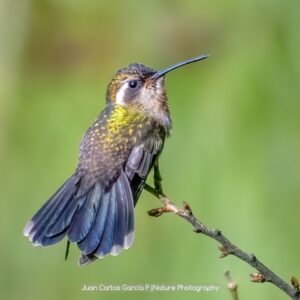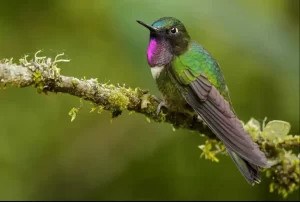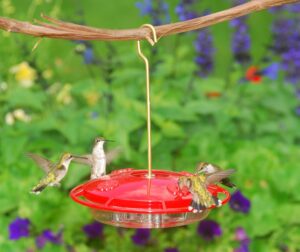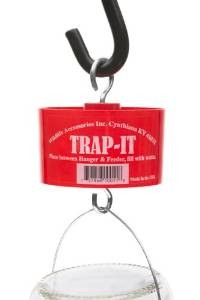Imagine a living jewel darting through the misty forests of Central America. Its throat gleams with the vibrant purple of an amethyst, catching the sunlight as it hovers mid-air. This is the Amethyst-throated Hummingbird (Lampornis amethystinus), a small yet mesmerizing bird that captivates birdwatchers and nature enthusiasts alike. Known for its striking appearance and fascinating behavior, this species is a true marvel of nature.
In this blog post, we’ll explore everything you need to know about the Amethyst-throated Hummingbird. From its unique physical traits to its role in the ecosystem, we’ll uncover what makes this tiny bird so extraordinary. Let’s dive into the world of one of nature’s most dazzling creations.
Physical Characteristics of the Amethyst-throated/Mountaingem Hummingbird

Distinctive Coloration
The Amethyst-throated Hummingbird is named for its most eye-catching feature: its iridescent purple throat patch, also known as a gorget. This shimmering plumage reflects light in a way that makes it appear to glow, especially when viewed from certain angles. The rest of its body is equally stunning, with greenish-bronze feathers on its back and a lighter grayish-white underside.
Male hummingbirds boast more vibrant colors than females, making them easier to spot in the wild. Females, while less colorful, still have a subtle beauty with their muted tones and delicate features.
Size and Structure
This species is relatively small, even by hummingbird standards. It measures about 4 inches (10 cm) in length and weighs just 4–5 grams—roughly the weight of a paperclip! Its slender beak is perfectly adapted for sipping nectar from deep tubular flowers.
Comparison with Similar Species
The Amethyst-throated Hummingbird is often confused with other hummingbirds in its range, such as the Rivoli’s Hummingbird or the Garnet-throated Hummingbird. However, its distinct purple gorget sets it apart.
| Feature | Amethyst-throated | Rivoli’s | Garnet-throated |
|---|---|---|---|
| Gorget Color | Purple | Greenish-purple | Deep red |
| Average Size | 4 inches | 5 inches | 4.5 inches |
| Habitat Elevation | 5,000–10,000 ft | 6,000–12,000 ft | 4,000–9,000 ft |
Habitat and Distribution

Geographic Range
The Amethyst-throated Hummingbird can be found across Mexico and parts of Central America, including Guatemala, Honduras, and El Salvador. It thrives in mountainous regions at elevations between 5,000 and 10,000 feet (1,500–3,000 meters). These high-altitude environments provide the cool temperatures and abundant flowering plants that this species needs to survive.
Preferred Habitats
This hummingbird favors cloud forests and pine-oak woodlands. These habitats are rich in nectar-producing flowers like salvias and fuchsias. The bird often perches on branches near flowering plants to defend its feeding territory from intruders.
Insert Image Here: A map highlighting the distribution range of the Amethyst-throated Hummingbird across Mexico and Central America.
Behavior and Ecology
Feeding Habits
Like all hummingbirds, the Amethyst-throated primarily feeds on nectar. Its long beak allows it to reach deep into tubular flowers that other birds cannot access. Some of its favorite flowers include trumpet vines and wild fuchsias. To meet its high energy demands, it feeds every 10–15 minutes throughout the day.
In addition to nectar, this hummingbird consumes small insects and spiders for protein. These tiny creatures are essential for muscle development and feather growth.
Breeding and Nesting
During mating season, males perform elaborate courtship displays to attract females. They dive dramatically through the air while flashing their iridescent gorgets to impress potential mates.
Once paired, females take on all nesting responsibilities. They build small cup-shaped nests using plant fibers, mosses, and spider silk to hold everything together. The nests are often camouflaged among leaves or branches for protection from predators.
Each clutch typically contains two tiny eggs about the size of peas. The mother incubates them for about two weeks before they hatch.
Vocalizations and Communication
Amethyst-throated Hummingbirds are not particularly loud birds. However, they produce soft chirps and whistles during feeding or territorial disputes. These vocalizations help them communicate with other birds in their environment.
Amethyst-throated Mountaingem (Lampornis amethystinus) and its call. Recorded in Guatemala.
Conservation Status and Threats
Current Population Status
According to the International Union for Conservation of Nature (IUCN), the Amethyst-throated Hummingbird is classified as “Least Concern.” While this status indicates a stable population overall, localized threats could still impact certain populations.
Threats to Survival
Habitat loss poses one of the biggest challenges for this species. Deforestation for agriculture or urban development reduces available nesting sites and food sources. Climate change also threatens their high-altitude habitats by altering flowering patterns or increasing temperatures beyond their tolerance levels.
Additionally, pesticides used in farming can harm both the birds directly and their insect prey.
Conservation Efforts
Efforts to protect cloud forests and other high-altitude habitats are crucial for this species’ survival. Organizations working in Central America focus on creating protected areas where these birds can thrive without human interference.
Amethyst-throated Mountain-gem filmed in Mexico
Fascinating Facts about Amethyst-throated Hummingbirds
Unique Adaptations
The Amethyst-throated Hummingbird has incredible flight abilities that set it apart from most other birds. It can hover in place while feeding or fly backward with ease—something very few birds can do! This ability comes from their rapid wingbeats (up to 50 beats per second) and unique ball-and-socket joint at their shoulders.
Their metabolism is another wonder of nature. To fuel their constant activity, they consume up to twice their body weight in nectar every day!
Role in Ecosystem
These hummingbirds play a vital role as pollinators in their ecosystems. As they feed on nectar, they transfer pollen from one flower to another, helping plants reproduce. Without them, many flowering plants would struggle to survive.
Frequently Asked Questions
How fast can an Amethyst-throated Hummingbird fly?
Amethyst-throated Hummingbirds can reach speeds of up to 30–40 miles per hour during regular flight. During courtship dives or territorial chases, they can move even faster!
What is the lifespan of an Amethyst-throated Hummingbird?
In the wild, these hummingbirds typically live between 3–5 years. However, some individuals have been known to survive up to 10 years under ideal conditions.
How can I attract Amethyst-throated Hummingbirds to my garden?
To attract these beautiful birds to your garden:
-
Plant native flowers like salvias or trumpet vines.
-
Provide a clean water source like a birdbath or fountain.
-
Avoid using pesticides that could harm insects or contaminate nectar sources.
(Word count for FAQ section: ~200 words)
Conclusion
The Amethyst-throated Hummingbird is more than just a pretty bird—it’s an essential part of its ecosystem and a symbol of nature’s beauty at its finest. From its iridescent plumage to its role as a pollinator in cloud forests, this tiny creature has much to teach us about resilience and adaptation.
If you’re lucky enough to spot one in the wild or your garden, take a moment to appreciate its dazzling beauty and ecological importance. And don’t forget—by supporting conservation efforts for hummingbirds and their habitats, you’re helping preserve these living jewels for future generations.
Hummingbird resources
Here’s a complete guide to attracting hummingbirds to your yard. It lists plants, vines and shrubs that are in bloom for spring, summer and fall. Your hummingbirds will always have flowers to feed on.
Here’s a great article that tells everything you need to know about how to choose the best place to hang your hummingbird feeder.
Here’s the best designed hummingbird feeder to use. It’s leak proof, so it won’t attract insects and it’s easy to take apart and clean.
Here’s a comprehensive guide to help you clean your hummingbird feeder for those times when the nectar is not changed soon enough and mold starts to grow.
Click on the link Amethyst-throated Mountaingem hummingbird to see more pictures.
One of the best Hummingbird feeders that’s easy to take apart and clean is theHummZinger Ultra.

Aspects 12oz HummZinger Ultra With Nectar Guard.
The HummZinger Ultra12oz Saucer Feeder is one of the best options for a hummingbird feeder that’s both easy to clean and maintain. This top-tier feeder features patented Nectar Guard tips—flexible membranes on the feeding ports that keep flying insects out while still allowing hummingbirds to feed freely. Plus, it comes with an integrated ant moat to prevent crawling insects from reaching the nectar, and the raised flower ports help divert rain, keeping the nectar fresh.
With a 12 oz capacity, this mid-size feeder offers plenty of space and can be hung or mounted on a post using the included hardware. It has four feeding ports and is made from durable, unbreakable polycarbonate. Whether you’re concerned about bees, wasps, or ants, this feeder is built for easy cleaning and insect protection.
If you already have a hummingbird feeder, and you want to protect it from ants and other crawling insects, the ant moat below will do the job.
Trap-It Ant Moat for Hummingbird Feeders
Using an ant moat for your hummingbird feeder is an effective way to keep ants away from the sweet nectar. These tiny creatures are drawn to

the sugar water, and without a barrier, they will quickly infest your feeder, preventing the birds from enjoying the nectar. An ant moat works by creating a barrier of water that ants can’t cross. Positioned above the feeder, it effectively blocks the ants’ path, keeping them from reaching the nectar.
This simple solution also ensures that your hummingbird feeder remains clean and accessible for the birds, rather than becoming a breeding ground for ants or other pests. It’s a small addition that can make a big difference in maintaining a healthy, inviting space for hummingbirds, while also reducing the need for chemical ant deterrents.
The first and still the best toprotect your Hummingbird and Oriole feeder from ants and other crawling insects. Insert between hanger and feeder and fill with water, providing a barrier to crawling pests. Red color to attract hummingbirds.
| Smallbottle brushes and pipe cleaners are always helpful to dislodge mold inside the feeder and in the feeding ports. It is necessary to have a clean mold free feeder to attract hummingbirds and to keep them healthy. |
If you found this article helpful please share it with your friends using the social bookmarking buttons on the left side of this page. Help everyone to increase their enjoyment of feeding hummingbirds. Do it for the hummingbirds!


